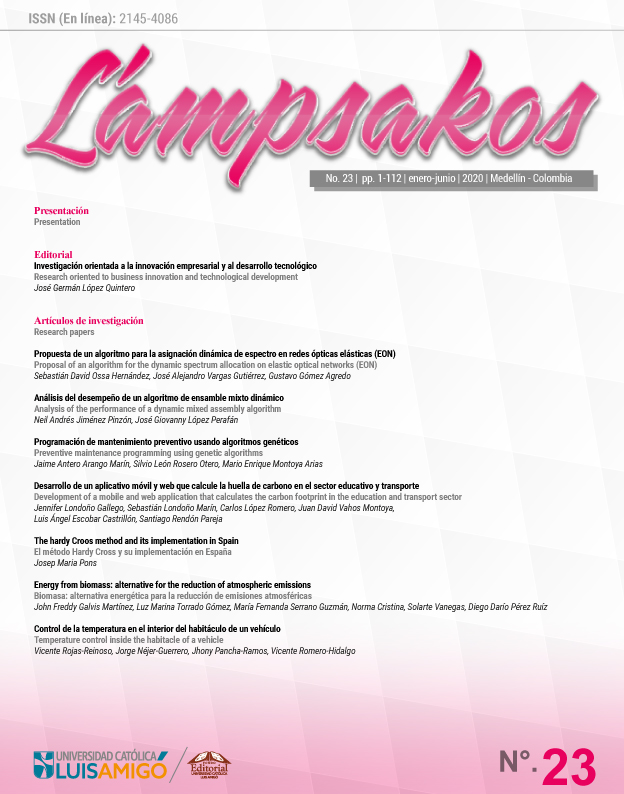Development of a mobile and web application that calculates the carbon footprint in the education and transport sector
DOI:
https://doi.org/10.21501/21454086.3302Keywords:
Software development, Transportation companies, Greenhouse gases (GHG), Carbon footprint, Educational institutions, TIC, Compensation, CO2 emissions, Mobile APP, Agroforestry projects, Web platform.Abstract
The daily activities that man carries out cause the increase of greenhouse gases (GHG), which are naturally found in the atmosphere, but by increasing their concentration, their residence time provides a greater potential for global warming, since its concentrations in the past were lower than the current ones. All industrialized countries generate the largest contribution of these GHGs. Information and communication technologies (ICT) make their contribution to solving this problem with
tools that help determine a CO2 (carbon dioxide) index produced by a specific activity, which is measured in tons per year.
The mobile application and web platform were developed with the agile SCRUM framework, which contains sprints and activities that were grouped into 4 stages. For the development architecture, Microsoft.NET was used, these tools allow
cross-platform developments for different mobile operating systems such as IOS or Android, with the Xamarin module. The results allowed to have a calculation of the CO2 emissions generated, being even more relevant the opportunity to compensate them by means of the good practices adopted by agroforestry systems with introduced or native species
Downloads
References
IPCC, “Cambio climático 2007: Informe de síntesis”. Contribución de los Grupos de trabajo I, II y III al Cuarto Informe de evaluación. Ginebra, Suiza, 2007.
A. Costello et al., “Managing the health effects of climate change”, Lancet, vol. 373, no. 9676, pp. 1693-1733, 2009. doi: 10.1016/S0140-6736(09)60935-1.
Parlamento Europeo, “Emisiones de gases de efecto invernadero por país y sector (infografía)”, 2018. [En línea]. Disponible en: https://www.europarl.europa.eu/news/es/headlines/society/20180301STO98928/emisiones-de-gases-de-efecto-invernadero-por-pais-y-sector-infografia.
R. Ewing, and F. Rong, “The Impact of Urban Form on U.S. Residential Energy Use”, Housing Policy Debate, vol. 19, no. 1, pp. 37-41, 2008. doi: 10.1080/10511482.2008.9521624
A. Y. Hoekstra, and y M. M. Mekonnen, “The water footprint of humanity”, PNAS, vol. 109, no. 9, pp. 3232–3237, 2012. doi: 10.1073/pnas.1109936109
H. Schneider, and y J. Samaniego, “La huella del carbono en la producción, distribución y consumo de bienes y servicios”, CEPAL República Fr., (FRA/08/004), 2009.
G. E. Sinden, “The contribution of PAS 2050 to the evolution of international greenhouse gas emission standards” The International Journal of Life Cycle Assessment, vol. 14, 195-203, 2009. doi: 10.1007/s11367-009-0079-3
J. O. Valderrama, C. Espíndola, y R. Quezada, “Huella de Carbono, un Concepto que no puede estar Ausente en Cursos de Ingeniería y Ciencias”, Formación Universitaria, vol. 4, no 3, pp. 3-12, 2011. doi: 10.4067/S0718-50062011000300002
H. Lei, F. Ganjeizadeh, P. K. Jayachandran, and P. Ozcan, “A statistical analysis of the effects of Scrum and Kanban on software development projects”, Robotics and Computer-Integrated Manufacturing, vol. 43, pp. 59-67, 2015. doi: 10.1016/j.rcim.2015.12.001
C. Espinoza-Galicia, A. Martínez-Endonio, M. Escalante-Cantu, y R. Martínez-Rangel, “Implementación de plataforma Web y aplicaciones móviles mediante buenas prácticas usando tecnología .NET,” Revista de Tecnologías de la Información y Comunicaciones, vol. 1, no. 1, pp. 42-49, 2017. Disponible en: https://www.ecorfan.org/spain/researchjournals/Tecnologias_de_la_Informacion_y_Comunicaciones/vol1num1/Revista_de_Tecnologia_de_la_Informacion_y_Comunicaciones_V1_N1_6.pdf
J. A. Vallejo Bermeo, “Estudio comparativo de los patrones para desarrollo del sitio de gestión de ventas para vidrialum”, tesis de grado de maestría, Facultad de Informática y Electrónica, Escuela Superior Politécnica de Chimborazo, Riobamba. Ecuador, 2014.
A. Blanch Cortès, “Desenvolupament d’ una app per a Android de la cartellera de cinema en català utilitzant MVVM i Android Architecture Components”, Treball de Final de Grau, Facultat d’Informàtica de Barcelona, Universitat Politècnica de Catalunya, 2018. Disponible en: https://pdfs.semanticscholar.org/5cbd/b530cf67b4207ef7b3206b5acc4d47147183.pdf
Downloads
Additional Files
Published
How to Cite
Issue
Section
License
In accordance with national and international copyrights, as well as publishing policies of "Fundación Universitaria Luis Amigó" and its Journal "Lámpsakos" (indexed with ISSN : 2145-4086), I (we ) hereby manifest:1. The desire to participate as writers and submit to the rules established by the magazine publishers.
2. The commitment not to withdraw the manuscript until the journal finishes the editing process of the ongoing issue.
3. That article is original and unpublished and has not been nominated or submitted together in another magazine; therefore, the rights of the article in evaluation have not been assigned in advance and they do not weigh any lien or limitation for use.
4. The absence of conflict of interest with commercial institution or association of any kind
5. The incorporation of the quotes and references from other authors, tending to avoid plagiarism. Accordingly, the author affirms that the paper being published do not violate copyright, intellectual property or privacy rights of third parties. Morover, if necessary there is a way of demonstrating the respective permits original copyright to the aspects or elements taken from other documents such as texts of more than 500 words, tables, graphs, among others. In the event of any claim or action by a third party regarding copyright on the article, the author (s) will assume full responsibility and come out in defense of the rights herein assigned. Therefore, for all purposes, the Journal "Lámpsakos" of the "Fundación Universitaria Luis Amigó" acts as a third party in good faith.
6. In the event of the publication of the article, the authors free of charge and on an exclusive basis the integrity of the economic rights and the right to print, reprint and reproduction in any form and medium, without any limitation as to territory is concerned, in favor of the Journal "Lámpsakos" of the "Fundación Universitaria Luis Amigó".








